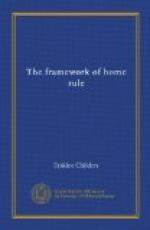FOOTNOTES:
[4] Class C. in Sir William Anson’s classification, “Law and Custom of the Constitution,” p. 253.
[5] J. Fisher, “End of the Irish Parliament” cited.
[6] MS. Autobiography cited by Lecky, vol. ii., p. 35.
[7] The best modern account of the commercial relations of Great Britain Mid Ireland is Miss Murray’s “Commercial Relations between England and Ireland.”
CHAPTER II
REVOLUTION IN AMERICA AND IN IRELAND
In the Old World and in the New, therefore, two societies, composed of human beings similar in all essential respects, were growing up under the protection of the British Crown; the one servile, the other free; the one stagnant where it was not retrograde, the other prosperous, progressive, and, by the magnetism of its own freedom, progress, and prosperity, steadily draining its Irish fellow of talent, energy, and industrial skill.
What was the ultimate cause of this glaring divergency? Religion, as a spiritual force, was not the root cause. The American Colonies, with three exceptions—the earliest Virginia, the latest Georgia, and the Catholic community of Maryland—were formed by Dissenters,[8] exiles themselves from persecution, but not necessarily forbearing to others, and, in the case of the New England Puritans, bitterly intolerant. It is interesting to observe that the Quakers and the Catholics, men standing at the opposite poles of theology, set the highest example of tolerance. Quaker Pennsylvania enforced absolute liberty of conscience, and Quakers in all the Provinces worked for religious harmony and freedom. Catholic Maryland, as long as its government remained in Catholic hands, and under the guidance of the wise and liberal Proprietary, Lord Baltimore, pursued the same policy, and attracted members of sects persecuted in New England.[9] The parallel with Ireland is significant. At the end of the seventeenth century, when a quarrel was raging between the Crown and Massachusetts over the persecution of Quakers in that Colony, and for a further period in the eighteenth century, Quaker missionaries and settlers were conducting a campaign of revivalism in Ireland with no molestation from the Catholics, though with intermittent obstruction from magistrates and Protestant clergy. Wesleyans received the same sympathetic treatment.[10] The tolerance shown by Irish Catholics, in spite of terrible provocation, is acknowledged by all reputable historians. Nor was Protestant intolerance, whether Anglican or Nonconformist, of a deeper dogmatic shade than anywhere else in the King’s dominions. But in Ireland it was political, economic, and social, while in America it was purely theological, and, moreover, purely American. The Episcopalian ascendancy in Ireland represented foreign interests, and therefore struck against Dissent as well as against Popery, and estranged both.




